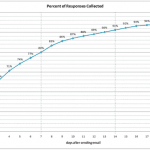Survey created. Check. Survey sent by email. Check. Survey posted to Facebook, Twitter, and LinkedIn. Check, check, and check. Log in to SurveyMonkey to see the results start coming in (yes, it’s addictive!).
But, the question is: How long should you really wait before starting to analyze your results?
How long, on average, does it take for the majority of respondents to complete a survey? We wanted to find out, so you could know how patient to be.
What we analyzed
We selected a random sample of 500,000 individual respondents who received survey invitations (using the SurveyMonkey email collector) in 2009 and 2010. We excluded the first week of January, the last week of November, and the last two weeks of December to normalize for US holidays. We limited our analysis to surveys that collected between 50 and 500 responses, so any single survey that received thousands (or millions—yes, some get millions!) of responses did not skew the results. And, we only included responses to surveys created by SurveyMonkey professional accounts since free accounts can only have up to 100 responses per survey.
What we learned
The majority of responses to surveys using an email collector were gathered in the first few days after email invitations were sent:
- 41% of responses were collected within 1 day
- 66% of responses were collected within 3 days
- 80% of responses were collected within 7 days

Only 11% of responses were collected during the second week of the survey period, and another 4% during the third week.
What does this mean for you?
You can peek during Day 1, but you might want to wait until Day 7 to run any significant analysis. And, if you’re trying to generate more responses, you might consider sending out a reminder email after a week to see if that triggers a bump from your laggards.
Looking for more data and insights?
Check out these additional posts on our blog where we answered the following questions:
What’s been your experience with respondents and how long it takes them to respond? Please share in the comments below.



